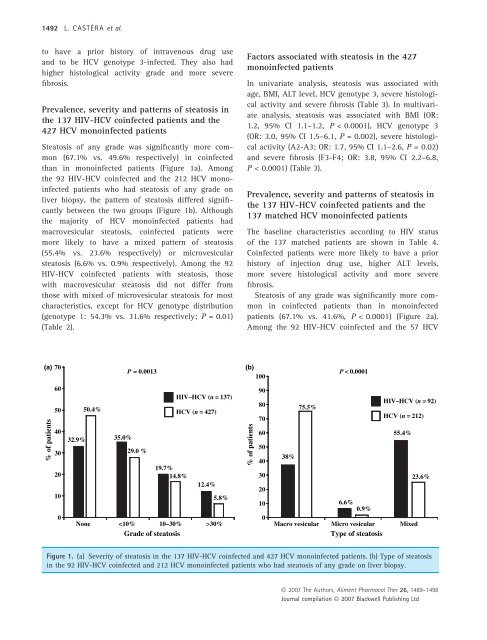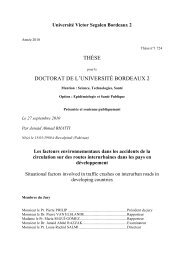You also want an ePaper? Increase the reach of your titles
YUMPU automatically turns print PDFs into web optimized ePapers that Google loves.
1492 L. CASTÉRA et al.<br />
to have a prior history of intravenous drug use<br />
and to be HCV genotype 3-infected. They also had<br />
higher histological activity grade and more severe<br />
fibrosis.<br />
Preva<strong>le</strong>nce, severity and patterns of steatosis in<br />
the 137 HIV-HCV coinfected patients and the<br />
427 HCV monoinfected patients<br />
Steatosis of any grade was significantly more common<br />
(67.1% vs. 49.6% respectively) in coinfected<br />
than in monoinfected patients (Figure 1a). Among<br />
the 92 HIV-HCV coinfected and the 212 HCV monoinfected<br />
patients who had steatosis of any grade on<br />
liver biopsy, the pattern of steatosis differed significantly<br />
between the two groups (Figure 1b). Although<br />
the majority of HCV monoinfected patients had<br />
macrovesicular steatosis, coinfected patients were<br />
more likely to have a mixed pattern of steatosis<br />
(55.4% vs. 23.6% respectively) or microvesicular<br />
steatosis (6.6% vs. 0.9% respectively). Among the 92<br />
HIV-HCV coinfected patients with steatosis, those<br />
with macrovesicular steatosis did not differ from<br />
those with mixed of microvesicular steatosis for most<br />
characteristics, except for HCV genotype distribution<br />
(genotype 1: 54.3% vs. 31.6% respectively; P = 0.01)<br />
(Tab<strong>le</strong> 2).<br />
Factors associated with steatosis in the 427<br />
monoinfected patients<br />
In univariate analysis, steatosis was associated with<br />
age, BMI, ALT <strong>le</strong>vel, HCV genotype 3, severe histological<br />
activity and severe fibrosis (Tab<strong>le</strong> 3). In multivariate<br />
analysis, steatosis was associated with BMI (OR:<br />
1.2, 95% CI 1.1–1.2, P < 0.0001), HCV genotype 3<br />
(OR: 3.0, 95% CI 1.5–6.1, P = 0.002), severe histological<br />
activity (A2-A3; OR: 1.7, 95% CI 1.1–2.6, P = 0.02)<br />
and severe fibrosis (F3-F4; OR: 3.8, 95% CI 2.2–6.8,<br />
P < 0.0001) (Tab<strong>le</strong> 3).<br />
Preva<strong>le</strong>nce, severity and patterns of steatosis in<br />
the 137 HIV-HCV coinfected patients and the<br />
137 matched HCV monoinfected patients<br />
The baseline characteristics according to HIV status<br />
of the 137 matched patients are shown in Tab<strong>le</strong> 4.<br />
Coinfected patients were more likely to have a prior<br />
history of injection drug use, higher ALT <strong>le</strong>vels,<br />
more severe histological activity and more severe<br />
fibrosis.<br />
Steatosis of any grade was significantly more common<br />
in coinfected patients than in monoinfected<br />
patients (67.1% vs. 41.6%, P < 0.0001) (Figure 2a).<br />
Among the 92 HIV-HCV coinfected and the 57 HCV<br />
(a) 70<br />
P = 0.0013<br />
(b)<br />
100<br />
P < 0.0001<br />
% of patients<br />
60<br />
50<br />
40<br />
30<br />
20<br />
10<br />
50.4%<br />
32.9% 35.0%<br />
29.0 %<br />
19.7%<br />
14.8%<br />
HIV–HCV (n = 137)<br />
HCV (n = 427)<br />
12.4%<br />
5.8%<br />
% of patients<br />
90<br />
80<br />
70<br />
60<br />
50<br />
40<br />
30<br />
20<br />
10<br />
38%<br />
75.5%<br />
HIV–HCV (n = 92)<br />
HCV (n = 212)<br />
55.4%<br />
23.6%<br />
6.6%<br />
0.9%<br />
0<br />
None 30%<br />
Grade of steatosis<br />
0<br />
Macro vesicular Micro vesicular Mixed<br />
Type of steatosis<br />
Figure 1. (a) Severity of steatosis in the 137 HIV-HCV coinfected and 427 HCV monoinfected patients. (b) Type of steatosis<br />
in the 92 HIV-HCV coinfected and 212 HCV monoinfected patients who had steatosis of any grade on liver biopsy.<br />
ª 2007 The Authors, Aliment Pharmacol Ther 26, 1489–1498<br />
Journal compilation ª 2007 Blackwell Publishing Ltd
















